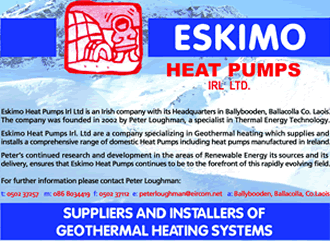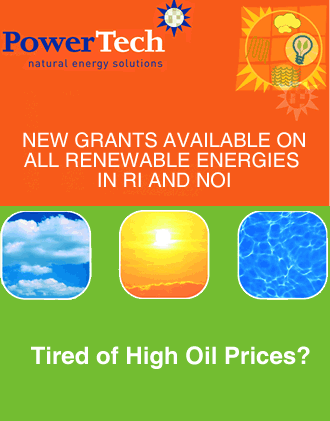- Heating
- Posted
Free Heat

As Ireland struggles to meet its commitments to reducing CO2 emissions in accordance with the Kyoto Protocol, the renewable energy sector continues to flourish as wind farms rapidly develop and solar energy becomes increasingly viable. But away from the elegance of sentinel windmills and the futurism of solar panels there is another source of power that is lying quietly under our very feet.
A geothermal heat pump (GHP) works by extracting heat energy from a low temperature source and upgrading it to a higher temperature so that it can be used for space and water heating. The temperature of our soil is remarkably stable below the frost line, usually between 8-12oC, and this represents a renewable resource of energy that homeowners everywhere can enjoy the benefits of. In addition GHPs can also be installed to harvest heat energy from nearby ponds, streams and wells.
The big difference between using a GHP to heat your home rather than a gas, oil or coal burner is that, rather than burning and converting stored chemical energy into heat energy, you are simply moving existing heat energy from your surroundings, amplifying it and then using it. This means that you will no longer need to spend money on fuels, giving your heating bills a high level of security away from the dynamics of future fossil fuel costs, (SEI est. €20,000 saving during a GHPs lifespan). The pump does require electricity to run, but for every one unit of electricity used to run the typical pump, 3 to 5 units of heat are produced making it efficient to a level of 400% compared with only 80% of a good oil burner. This is especially significant given that 80% of Irelands energy consumption is used for heat production, (2.4 million tonnes of oil every year), making it the main contributor of CO2, (11 million tonnes annually). GHPs also use 25-50% less electricity than a conventional heating/cooling system. Their low running costs and efficiency can result in heating bills being reduced by as much as 70%, and also, crucially, reduce the environmental impact considerably. Indeed, if you choose to power your GHP from green electricity then the energy that you use will be 100% renewable, with absolutely no CO2 emissions.
In order to understand how a typical GHP works the process can be divided into three basic sections. Firstly, a medium with a boiling point lower than the geothermal heat source temperature is channelled via piping through the heat source (earth, groundwater), allowing the heat to be extracted into it. As this extracts the heat from the source its temperature rises. Secondly, this medium is then passed through a compressor that increases its density, pressure and temperature allowing it to be boosted to a suitable level. Finally, the heat is transferred from the heated medium to a distribution fluid (water or air) so that the heat can be distributed throughout the building. At this point the medium loses its heat and returns to its initial state and the process begins a new cycle. The technology involved is mature and is not dissimilar to the traditional process that allows your refrigerator to extract the heat from inside it. GHPs have been used extensively in the US (40,000 pumps installed each year) and are considered as the normal way to heat and cool a building in Sweden, Austria and Germany.
For the homeowner interested in investing in a GHP, there are a number of factors to consider; firstly deciding what heat source is best for you. Typically the piping is laid in horizontal or vertical trenches in an open space such as a garden, but if you live close to a pond or stream this could be your source of heat. Given that in most cases the specific demands and heat requirements differ, the best way is to get an expert in to assess and advise on the optimum system required for your needs.
There are a number of heat pumps on the market that operate in slightly different ways. One distinction is whether the pump is indirect or direct. Indirect heat pumps typically use antifreeze as a medium and use a heat exchanger as an evaporator to heat gas from the antifreeze. This heated gas is then used to heat the water that will be circulated into the home. A direct heat pump on the other hand, rather than using a liquid mediator, channels the refrigerant gas directly out into the ground to collect heat.
As the gas can be distributed at a lower temperature than antifreeze, the temperature difference between the ground and the gas is greater than it would be with antifreeze, hence allowing more heat to be collected. This method allows a substantially greater level of efficiency to be achieved, although direct heat pumps are more expensive than indirect heat pumps. Ultimately however, the more money that you are prepared to invest into your heating system initially, the greater the amount of money you will eventually save every year after.
Another important factor to consider is ensuring that the heat pump you have installed is sufficiently sized to meet your heating demands. Ideally a heat pump should generate the majority of its heat at night using low peak electricity. However if you have a heat pump that is too small, it will consequently be required to work more often and during daytime hours. At the end of the day the money that should have been saved will be lost through a higher electricity bill.
Finally, the process through which the heat is distributed throughout the building is another factor. The best method of distribution utilizes sub floor radiant heating, which involves circulating the heated water through pipes that are embedded into the floor, allowing both conductive and convective heating to occur. This method is well liked by architects, as it allows more freedom in design. With the piping hidden furniture can also be arranged without restriction.
Retrofitting your home with sub floor piping can be expensive. In the case of a new building however, the piping can be installed as the building is being constructed, and indeed it would be advisable to consider incorporating sub floor heating into any new building at this stage. Even if the consumer is unable to invest in a GHP straight away, the option to adapt their building to this at a later date can reap huge savings.

Should sub floor heating be impractical, traditional heating radiators can still be used effectively to distribute heat. However, due to the comparatively lower temperature of the warm water produced (40oC/55oC dependant on system), they may need to be sized approximately 25% larger to compensate for the lower temperature differential, thus allowing convection to occur at maximum efficiency. In addition modified radiators with air fans can also be utilised successfully to distribute heat. GHPs are also extremely low maintenance and durable, given that the main “workhorse” part of the system is piping buried under the ground and has no moving parts.
Geothermal heating systems require on average one-third of the maintenance of a conventional heating system, and often the piping will carry warranties of 25-50 years. One impediment with GHP technology is that it is usually more expensive to install than other heating systems. Due to the exceptional efficiency of GHP however, the initial extra cost is usually recouped within the first few years of operation, after which large savings can be enjoyed for years to come. It should also be stressed that, as with any heating system, sufficient insulation is essential to maintaining a high level of efficiency.
At present the geothermal sector is the subject of an immense degree of attention. One source that Construct Ireland spoke to estimated that interest in the area has tripled or quadrupled in the last 4 months alone. The Irish people want to get involved in renewable energy and enjoy the associated savings and benefits, however there is presently no governmental grant scheme to encourage the domestic uptake of renewable energy. Given that Ireland, with CO2 emissions of 31% above the 1990 level at present is severely in breach of its commitments under the Kyoto Protocol, there is a growing sentiment that the government could and should be actively encouraging the domestic uptake of these clean renewable energy sources.
In addition to the absence of domestic grants, the government also insists on charging full VAT on renewable supplies, unlike the UK and many other European countries that are actively encouraging the renewable sector by substantially reducing the VAT level. By adopting Geothermal heating and renewable energy the Irish public are saving the government money and safeguarding the country and their children’s future. A situation where people should have to pay an additional 21% VAT to the government for choosing a renewable, environmentally beneficial energy source could be seen to call into question the government’s commitment to the environment. Construct Ireland suggests writing to your local TD and objecting. The demand for change is at a critical point and your actions can make a difference.
Unfortunately for the consumer, there is also no government-initiated means of certification for installers of geothermal heating systems. In the last few years the number of operators in the sector has mushroomed, and whilst this increase in activity is extremely encouraging for all, from the consumers point of view, in order to be able to commit with confidence an investment in geothermal heating it is advisable to ask to contact, and if possible view the companies previous clients. Ultimately for the homeowner interested in geothermal heat, the chance to contact satisfied customers who are operating similar systems to one that they might be interested in investing in, could carry more influence that any number of statistics and graphs.
Geothermal energy is used widely in Europe and there is absolutely no reason why it cannot also be widely embraced here in Ireland. Previously people may have been hesitant about the initial cost of a geothermal system however increasingly in recent years, the Irish homeowner is prepared to make the investment with confidence, due to a growing recognition of the massive savings to be made and benefits to be enjoyed from such a clean renewable energy resource.
If you are interested in learning more about geothermal heat pumps, you can contact:
Sustainable Energy Ireland
Renewable Energy Information Office
Hotline: 023 42193
Website: www.irish-energy.ie/reio.htm
Email: This email address is being protected from spambots. You need JavaScript enabled to view it.
- renewable
- Geothermal
- energy
- grants
- sei
- sentinel windmills
- Heating
- heat pumps
- emissions
- home heating
- Ireland
Related items
-
 King of the castle
King of the castle -
 Energy poverty and electric heating
Energy poverty and electric heating -
 Build Homes Better updates Isoquick certification to tackle brick support challenge
Build Homes Better updates Isoquick certification to tackle brick support challenge -
 Flat earth
Flat earth -
 Material matters - A palette for a vulnerable planet
Material matters - A palette for a vulnerable planet -
 Derelict to dream home
Derelict to dream home -
 Final opportunity for construction professionals to secure 80 per cent training subsidies
Final opportunity for construction professionals to secure 80 per cent training subsidies -
 Big picture - Points of access to resilient living
Big picture - Points of access to resilient living -
 Storm breaker
Storm breaker -
 Enniscorthy to host ‘make or break’ sustainable building summit
Enniscorthy to host ‘make or break’ sustainable building summit -
 Ecocem executive John Reddy becomes the first Irish President of the Institute of Concrete Technology
Ecocem executive John Reddy becomes the first Irish President of the Institute of Concrete Technology -
 Reimagining the architect
Reimagining the architect



